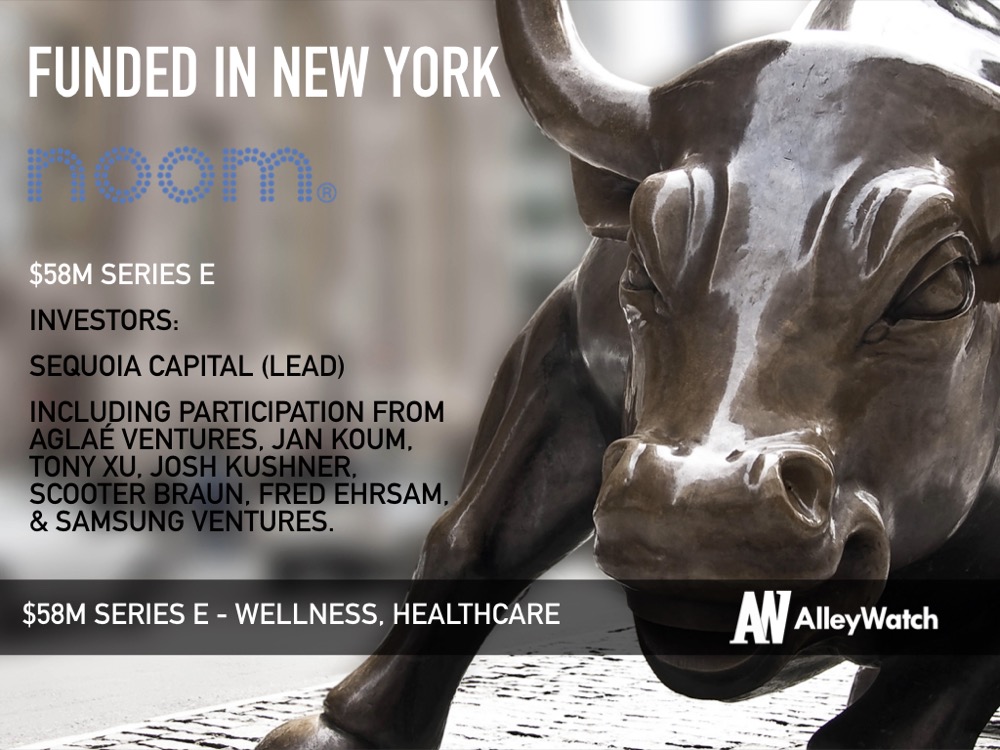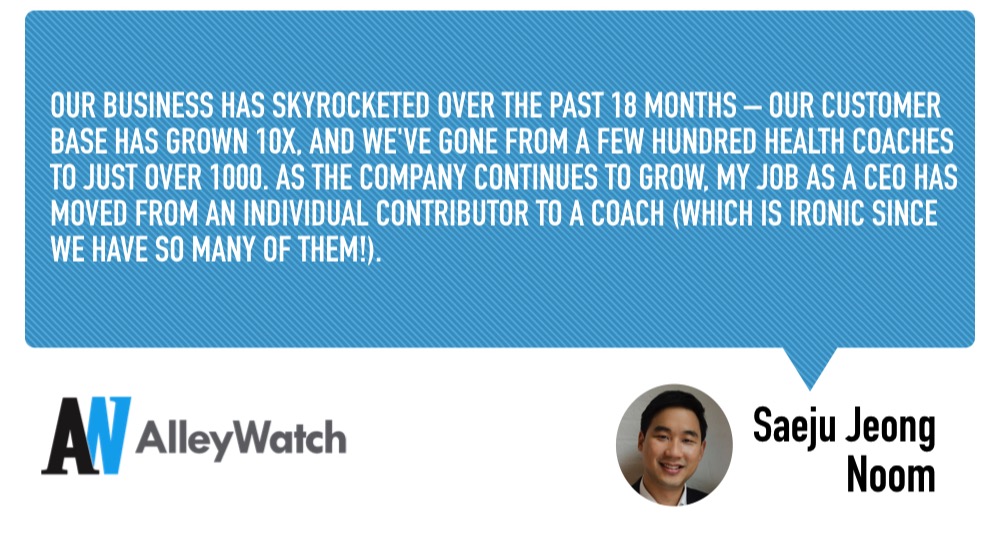Many people tend to turn to various figures – celebrities, influencers, bodybuilders – for answers about food and how to live a healthy lifestyle, but you can’t look at others to understand your personal relationship with food. Noom helps people live a healthier lifestyle through its interdisciplinary, psychology-based program that is rooted in Cognitive Behavioral Therapy (CBT). Noom teaches its users using clinically-validated tools and skills to help them lose weight, develop healthier habits, and sustain changes.
AlleyWatch caught up with Noom CEO and cofounder Saeju Jeong to learn more about the company’s award-winning approach to weight loss, the company’s future plans, and latest round of funding, which brings its total funding to $114.7M.
Who were your investors and how much did you raise?
Noom raised $58M our Series E, led by Sequoia Capital. Some of our bigger named investors included Groupe Arnault’s tech arm, Aglaé Ventures; Jan Koum, co-founder of WhatsApp; Tony Xu, cofounder of DoorDash; Josh Kushner, cofounder of Oscar Health; Scooter Braun, founder of SB Projects; Fred Ehrsam, cofounder of Coinbase; and existing investor Samsung Ventures.
Tell us about the product or service that Noom offers.
Noom combines the power of technology with the empathy of human coaches to deliver successful behavior change at scale. Though we offer a number of behavior change programs, our most popular is Noom’s Healthy Weight program, which has helped millions of users lose weight and develop healthier habits. It’s a four-month program that provides original psychology-based content, best-in-class food logging and exercise tracking tools, a support group, and a personal health coach to guide you through your journey.
Noom also offers prediabetes, diabetes, and hypertension management programs. Noom’s fully mobile diabetes prevention program (DPP) was the first of its kind to be recognized by the CDC, and the only 100% mobile program clinically-proven in a peer-reviewed journal. Studies showing the efficacy of Noom’s prediabetes, diabetes and hypertension programs have appeared in over a dozen medical journals, including the Journal of Human Hypertension, Nature’s Scientific Reports, and British Medical Journal Open Diabetes Research & Care.
What inspired you to start Noom?
 My cofounder, Artem Petakov, and I wanted to tackle a big problem and make a real difference in people’s lives. We defined our mission before we created our first product – to help people everywhere lead healthier lives. There are tons of fad diets, cleanses, and quick fixes out there, but none of them work long-term. Successful, long-term weight loss is hard. It’s less about “eat this, not that”, and more about tackling the relationship people have with food – why they make certain food choices or eat how much they do. Ultimately we wanted to tackle what everybody was failing to address: the psychology of health behaviors. We wanted to create a fun, engaging, effective, and most importantly, sustainable program to help people lose weight and develop healthier habits for life. This was the beginning of Noom.
My cofounder, Artem Petakov, and I wanted to tackle a big problem and make a real difference in people’s lives. We defined our mission before we created our first product – to help people everywhere lead healthier lives. There are tons of fad diets, cleanses, and quick fixes out there, but none of them work long-term. Successful, long-term weight loss is hard. It’s less about “eat this, not that”, and more about tackling the relationship people have with food – why they make certain food choices or eat how much they do. Ultimately we wanted to tackle what everybody was failing to address: the psychology of health behaviors. We wanted to create a fun, engaging, effective, and most importantly, sustainable program to help people lose weight and develop healthier habits for life. This was the beginning of Noom.
How is Noom different?
Noom is not a diet that requires you to count calories, skip meals, cut carbs, or any other “quick fix”, non-sustainable tricks. Instead, Noom fosters self-awareness and self-efficacy. We empower customers to change their behavior with a psychology-based program that begins with the mind, and it is scientifically proven to work.
What market does Noom target and how big is it?
Noom’s market has no bounds – it’s anyone and everyone who wants to lead a healthier life. Currently, we offer behavior change programs that help people lose weight, prevent or manage diabetes, and manage hypertension. We plan on expanding our offering to tackle other conditions that can be prevented or improved through lifestyle interventions.
What’s your business model?
While we have both consumer and enterprise markets, our biggest market is direct to consumer. We sell healthy weight and lifestyle programs to consumers. We also partner with insurance companies and employers to deliver programs that prevent and manage pre-chronic and chronic conditions, to help their respective populations lead healthier lives.
How has the business and your role changed since we last spoke in 2014?
Our business has skyrocketed over the past 18 months – our customer base has grown 10x, and we’ve gone from a few hundred health coaches to just over 1000. As the company continues to grow, my job as a CEO has moved from an individual contributor to a coach (which is ironic since we have so many of them!).
With our continued growth, our biggest bottleneck as a company is hiring. We have really high standards when it comes to hiring – we aren’t just looking to fill positions, we’re looking to bring on the best talent around. I spend a lot of time on recruiting to make sure we fill each position with incredible people who embody Noom’s spirit and are passionate about Noom’s mission.
Since Noom has also gotten a lot of media coverage recently, we’ve had many companies reach out to partner with us. So right now, a lot of my time is spent on that too.
What was the funding process like?
In general, fundraising is intense. In 2018, our revenue was 5x our revenue in 2017. Because our business grew so fast, we definitely had an easier time meeting with all the top VCs, but there are different challenges we faced in raising growth capital versus raising more speculative capital like you do in earlier rounds of fundraising. In earlier stages, it’s about selling a dream and getting VCs to help support you in making your dream a reality. In later stages, like our most recent round, there is a lot more focus on numbers. VCs are interested in the data – cohorts, retention rates, CAC, and more – and we needed to deliver results.
In earlier stages, it’s about selling a dream and getting VCs to help support you in making your dream a reality. In later stages, like our most recent round, there is a lot more focus on numbers. VCs are interested in the data – cohorts, retention rates, CAC…
Fortunately, we’ve moved beyond the days of selling a dream and are in a place where we’re backed by impressive growth and numbers. At the end of the day, we were interested in finding the best partner to help us continue to grow, which is why we chose Sequoia.
What are the biggest challenges that you faced while raising capital?
Since fundraising is all-consuming, it’s really difficult to balance with all of my other day-to-day responsibilities. However, I’ve accepted that while I fundraise, I won’t be able to work as much on the business as I usually do, and I’ve learned to lean on my team for support during this time. I truly have an incredible team working with me and I trust them to manage the business. Like always, they rose to the occasion.
What factors about your business led your investors to write the check?
You’d really have to ask Sequoia that one! All jokes aside, our huge, addressable market, hypergrowth, and ability to expand into different verticals makes Noom attractive to potential investors.
What are the milestones you plan to achieve in the next six months?
As Noom enters its next stage of growth, our company will use the funds from the latest round to grow our team and improve our customer experience.
Specifically, we want to hire the talent who can create, test, and iterate on the ideas we have to improve our product at-scale (product managers, engineers, and the like), while delivering meaningful results and unmatched customer experience. We have so many ideas about how we can improve and expand our product, but we need the resources to make it happen.
We’re also focused on growing the team who will grow our user base (growth marketers, brand and creative talent, and more), to ultimately help us reach and change even more lives.
What advice can you offer companies in New York that do not have a fresh injection of capital in the bank?
My best advice is this: Even after you raise a round of capital, think (and act) like you’re poor.
My best advice is this: Even after you raise a round of capital, think (and act) like you’re poor.
Save your pennies and don’t waste your money on hunches. Invest your money only when there is data to support your ideas, and double down when you find a test that really moves the metrics you’re interested in.
We use experiments to learn, so focus on lightweight experiments that allow you to move quickly since the reality is that most experiments fail. But, if you do enough experiments, you’ll find the path forward, and learn where to focus your time, effort, and money. That being said, it’s also important to think outside the box and also try a few larger experiments, because as they say: “fortune favors the bold.” It’s all about striking a balance.
Where do you see the company going now over the near term?
As our user base continues to grow, our biggest focus now is scaling our talent, and continuing to get the word out. With thousands of customers signing up every day, we’re in a really great place. Our users love our product and are continuing to achieve incredible results – it’s truly inspiring! That being said, we have so many ideas of how we can continue to improve our product and deliver even better outcomes, and I’m excited to keep learning and growing.
What’s your favorite restaurant in the city?
I love New Wonjo, an authentic Korean BBQ restaurant in Koreatown. The Ju Mool Luk is my favorite dish – boneless, marinated short ribs.





